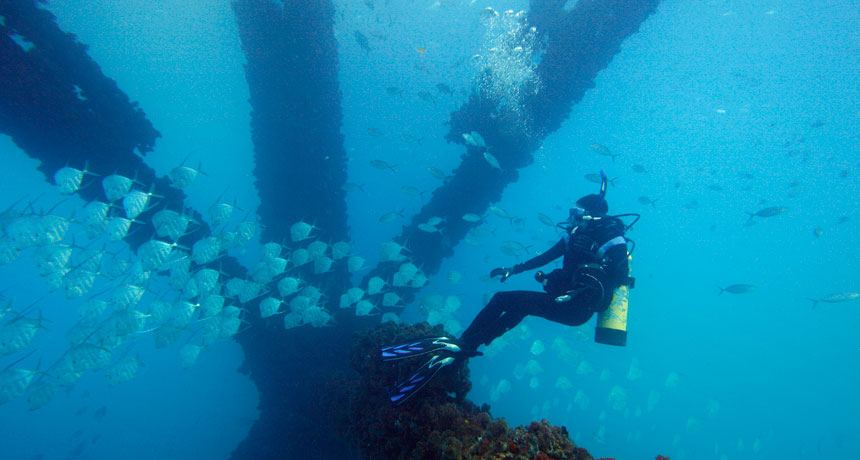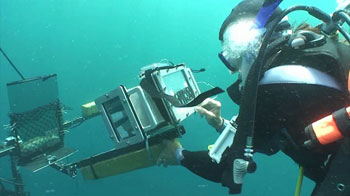Some fish wear an invisibility cloak
Skin and scales contain crystals that help fish ‘disappear’ in open water

Shiny fish called “lookdowns” school off the Texas coast.
UT Austin
By Ilima Loomis
Fish that swim in the open ocean have nowhere to hide from hungry predators. But some may have evolved a kind of natural invisibility cloak that helps them hide in plain sight. Understanding how it works may let scientists and engineers develop new forms of ocean camouflage.
Some species of fish have microscopic structures called platelets in their skin and scales. These platelets look like thin, flat crystals. And they are so small that 100 could fit in a grain of sand! “It’s why fish seem so shiny and reflective,” says Molly Cummings. She is a biologist at the University of Texas at Austin. She also is a co-author of the new study.
For many years, scientists thought fish camouflaged themselves by reflecting light in the same way a mirror does. But much of the light beneath the ocean’s surface is polarized. That means the light is scattered in a specific pattern, with all the light waves moving along the same plane. Biologists have long known that many ocean animals could detect changes in polarized light. They wondered if some fish might also have evolved a way to blend in to these light patterns.
To find out, Cummings and her colleagues built a video polarimeter (PO-lar-IM-eh-ter). This is a camera that lets scientists see polarized light as fish do. The team used netting to hold a fish in place on an underwater platform against a mirror. Then they took pictures of the fish from more than 1,500 different angles.

But open-ocean fish are not camouflaged evenly. Their platelets are strategically placed on different parts of the body, the researchers found. This changes how the body reflects light. The result? The fish were camouflaged most effectively when being looked at from an angle of about 45 degrees in every direction from the tail or head. These are the “chase angles” — the positions from which a predator would most likely approach. (That angle is about half the size of the inside angle of any corner of a square.)
Based on earlier laboratory research, the scientists had suspected that fish would be well hidden at chase angles. But they were surprised to find that the fish also had good camouflage when viewed from the side. From that angle they would be in full view of a predator. “It’s at those direct views that the fish also does a fantastic job at minimizing contrast,” Cummings says.
Not all scientists are so impressed. Thomas Cronin, a visual ecologist at the University of Maryland, Baltimore County, says the fact that shiny fish are camouflaged in polarized light has been known for a long time. And the difference in contrast provided by the reflectivity is relatively small, he says.
The camo effect is noticeable. Still, he argues, these fish are “not by any means invisible.”
Cronin says researchers should next investigate whether the kinds of high-speed predators that hunt these shiny fish — like marlin, tuna and mahimahi — have vision that can deal with polarized light. This would reveal whether polarization is even useful as a camouflage for fish like the lookdown.
But Cummings and the scientists she worked with aren’t just interested in learning about fish. The U.S. Navy is looking for new ways to cloak and hide submarines and other vessels in open water. The findings from these fish could help materials scientists and military technologists design new forms of ocean camouflage. Indeed, the Navy helped fund her team’s research.
The findings show how understanding evolution can help humans design better technology, Cummings says. “This is a great example of nature solving problems for us.”
Power Words
(for more about Power Words, click here)
angle The space (usually measured in degrees) between two intersecting lines or surfaces at or close to the point where they meet.
biology The study of living things. The scientists who study them are known as biologists.
camouflage Hiding people or objects from an enemy by making them appear to be part of the natural surroundings. Animals can also use camouflage patterns on their skin, hide or fur to hide from predators.
crystal A solid consisting of a symmetrical, ordered, three-dimensional arrangement of atoms or molecules. It’s the organized structure taken by most minerals. Apatite, for example, forms six-sided crystals. The mineral crystals that make up rock are usually too small to be seen with the unaided eye.
engineer A person who uses science to solve problems. As a verb, to engineer means to design a device, material or process that will solve some problem or unmet need.
environment The sum of all of the things that exist around some organism or the process and the condition those things create for that organism or process. Environment may refer to the weather and ecosystem in which some animal lives, or, perhaps, the temperature, humidity and placement of components in some electronics system or product.
evolution A process by which species undergo changes over time, usually through genetic variation and natural selection. These changes usually result in a new type of organism better suited for its environment than the earlier type. The newer type is not necessarily more “advanced,” just better adapted to the conditions in which it developed.
evolve To change gradually over generations, or a long period of time. In living organisms, the evolution usually involves random changes to genes that will then be passed along to an individual’s offspring. These can lead to new traits, such as altered coloration, new susceptibility to disease or protection from it, or different shaped features (such as legs, antennae, toes or internal organs). Nonliving things may also be described as evolving if they change over time. For instance, the miniaturization of computers is sometimes described as these devices evolving to smaller, more complex devices.
materials science The study of how the atomic and molecular structure of a material is related to its overall properties. Materials scientists can design new materials or analyze existing ones. Their analyses of a material’s overall properties (such as density, strength and melting point) can help engineers and other researchers select materials that best suited to a new application.
microscopic An adjective for things too small to be seen by the unaided eye. It takes a microscope to view such tiny objects, such as bacteria or other one-celled organisms.
oceanography The branch of science that deals with the physical and biological properties and phenomena of the oceans. People who work in this field are known as oceanographers.
physicist A scientist who studies the nature and properties of matter and energy.
polarization The scattering of light in a specific pattern, with all light waves traveling on the same plane.
predator (adjective: predatory) A creature that preys on other animals for most or all of its food.
reef A ridge of rock, coral or sand. It rises up from the seafloor and may come to just above or just under the water’s surface.
technology The application of scientific knowledge for practical purposes, especially in industry — or the devices, processes and systems that result from those efforts.







